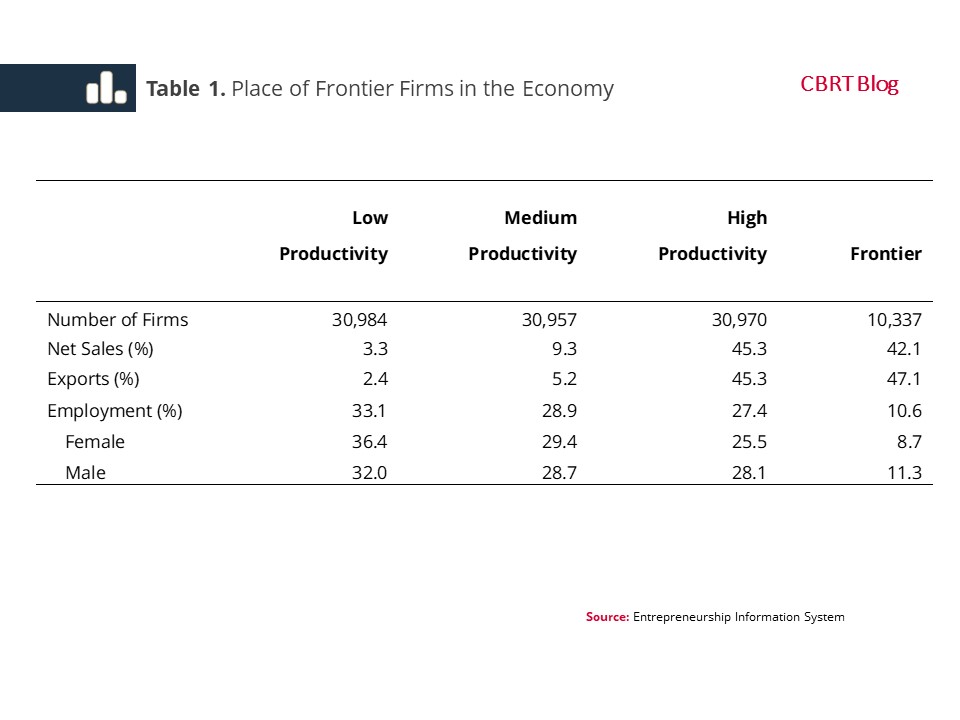Firms with the highest level of productivity significantly contribute to overall productivity gains and accordingly, to sustainable growth by enabling technological innovation and widening the use of new globally-developed technologies in the local economy. In this blog post, we classify the firms with the highest level of productivity as frontier firms and investigate the characteristics that distinguish these firms from other firms in terms of employment structure.1
We calculate the partial labor productivity of manufacturing firms as the ratio of net real sales to the number of employees, using the micro data for 2018 in the Entrepreneurship Information System (EIS). Then, we assess the productivity levels of firms based on the distribution of productivity in the sectors they belong to. Accordingly, we identify the firms in the highest 10th percentile as frontier firms while we divide other firms into three equal groups according to productivity distribution and classify them as low, medium, and high-productivity firms.
The role of frontier firms in the economy as compared to other firm groups is summarized in Table 1. Although the number of frontier firms is, by definition, small, they account for almost half of net sales and exports. While frontier firms have a share of 10.6% in employment, the ratio is lower in female employment than in male employment.

This raises the question: Does the occupational composition of frontier firms differ from other firms? To examine this, we employ the skill levels from the international standard classification of occupations (ISCO 2008) prepared by the International Labour Organization (ILO,2012). Table 2 presents the occupational distribution of employees by firm groups based on skill levels. In this categorization, occupations are divided into four groups based on the required skill level. Accordingly, the ratio of employees working in the occupations that require the highest skill level (skill level 4) is 13.2% in frontier firms. This ratio is below 10% in other firm groups. The same is also true for skill level 3. In a nutshell, the skill levels of occupations performed by frontier firm employees are above those of other firms.
Chart 1 shows the divergence of firm groups in terms of average skill level by gender. Accordingly, for both male and female employees, occupational skill levels increase as the productivity levels of firms increase. However, this trend is non-linear. The increase observed when shifting from high-productivity firms to frontier firms is larger than the increase observed in the shifts between other firm categories. A breakdown by gender also reveals a significant divergence. While women in other firm groups work in lower-skill jobs compared to men, the situation in frontier firms is just the opposite. In other words, productivity-wise frontier firms are also frontiers in terms of female employment in high-skill jobs.

We move on to investigate whether the relation between firm productivity and skill levels of employees is reflected in wages. Chart 2 shows the average daily wages by firm groups. Accordingly, productivity growth is accompanied by an increase in wages for both men and women. However, as is the case for skill levels, this trend is also non-linear. The divergence between frontier firms and high-productivity firms in terms of average wage is greater than the divergence among other firm groups. Hence, working in frontier firms is the most important step for a wage increase. The productivity-based rise in wages shows a similar pattern for men and women. Thus, the wage gap between men and women does not change much in terms of level. However, in terms of percentage changes as mostly used in the literature, the gender wage gap is lower in frontier firms. While the average wage of men is around 23% percent higher than that of women in other firm groups, this gap narrows to 18.4% in frontier firms. A reason for this narrowing is that women in frontier firms work in jobs with a higher average skill level compared to men.

To sum up, frontier firms also take a leading role in the labor market. The ratio of employees working in high-skill jobs is higher in these firms. The higher skill level also affects wages. The share of frontier firms in female employment is lower than their share in male employment. However, women working in frontier firms are employed in higher-skill jobs compared to men. Moreover, the gender wage gap is narrower in these firms.
[1] Atabek-Demirhan (2017) contains information regarding the effects of frontier firms on other fields of the economy.
References
Atabek Demirhan, A. (2018). Catch-Up in the Turkish Manufacturing Industry: The Role of National and Regional Frontiers, CBRT Blog, 20/04/2018.
ILO (2012), International Standard Classification of Occupations: Structure, Group Definitions and Correspondence Tables
